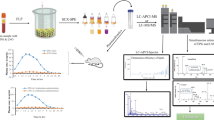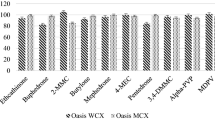Abstract
The aim of this work was to develop and validate a solid-phase extraction (SPE) method for the analysis of cannabinoids with emphasis on a very extensive and effective matrix reduction in order to ensure constant good results in selectivity and sensitivity regardless of the applied measuring technology. This was obtained by the use of an anion exchange sorbent (AXS) and the purposive ionic interaction between matrix components and this sorbent material. In a first step, the neutral cannabinoids ∆9-tetrahydrocannabinol (THC) and 11-hydroxy-∆9-tetrahydrocannabinol (11-OH-THC) were eluted, leaving 11-nor-9-carboxy-∆9-tetrahydrocannabinol (THC-COOH) and the main interfering matrix components bound to the AXS. In a second step, exploiting differences in pH and polarity, it was possible to separate matrix components and THC-COOH, thereby yielding a clean elution of THC-COOH into the same collecting tube as THC and 11-OH-THC. Even when using a simple measuring technology like gas chromatography with single quadrupole mass spectrometry, this two-step elution allows for an obvious decrease in number and intensity of matrix interference in the chromatogram. Hence, in both plasma and serum, the AXS extracts resulted in very good selectivity. Limits of detection and limits of quantification were below 0.25 and 0.35 ng/mL for the neutral cannabinoids in both matrices, 2.0 and 3.0 ng/mL in plasma and 1.6 and 3.3 ng/mL in serum for THC-COOH. The recoveries were ≥79.8 % for all analytes. Interday and intraday imprecisions ranged from 0.8 to 6.1 % relative standard deviation, and accuracy bias ranged from −12.6 to 3.6 %.



Similar content being viewed by others
References
UNODOC, World drug report 2014: http://www.unodc.org/documents/wdr2014/World_Drug_Report_2014_web.pdf.
Huestis MA, Barnes A, Smith ML (2005) Estimating the time of last cannabis use from plasma Δ9-tetrahydrocannabinol and 11-nor-9-carboxy-Δ9-tetrahydrocannabinol concentrations. Clin Chem 51:2289–2295
Weinmann W, Goerner M, Vogt S, Goerke R, Pollak S (2001) Fast confirmation of 11-nor-9-carboxy-Δ9-tetrahydrocannabinol (THC-COOH) in urine by LC/MS/MS using negative atmospheric-pressure chemical ionisation (APCI). Forensic Sci Int 121:103–107
Schürenkamp J, Gasse A, Pfeiffer H, Köhler H (2015) Difficulties arising from new blood collecing tubes for ethanol determination. Toxichem Krimtech 82(Special issue):268–272
Toennes SW, Kauert GF (2001) Importance of vacutainer selection in forensic toxicological analysis of drugs of abuse. J Anal Toxicol 25:339–343
Fernandez MMR, De Boeck G, Wood M, Lopez-Rivadulla M, Samyn N (2008) Simultaneous analysis of THC and its metabolites in blood using liquid chromatography–tandem mass spectrometry. J Chromatogr, B 875:465–470
Kemp PM, Abukhalaf IK, Manno JE, Manno BR, Alford DD, Abusada GA (1995) Cannabinoids in humans. I. Analysis of Δ9-tetrahydrocannabinol and six metabolites in plasma and urine using GC-MS. J Anal Toxicol 19:285–291
Andrews R, Paterson S (2012) A validated method for the analysis of cannabinoids in post-mortem blood using liquid–liquid extraction and two-dimensional gas chromatography–mass spectrometry. Forensic Sci Int 222:111–117
Steinmeyer S, Bregel D, Warth S, Kraemer T, Moeller MR (2002) Improved and validated method for the determination of Δ9-tetrahydrocannabinol (THC), 11-hydroxy-THC and 11-nor-9-carboxy-THC in serum, and in human liver microsomal preparations using gas chromatography–mass spectrometry. J Chromatogr, B 772:239–248
Brenneisen R, Meyer P, Chtioui H, Saugy M, Kamber M (2010) Plasma and urine profiles of Δ9-tetrahydrocannabinol and its metabolites 11-hydroxy-Δ9-tetrahydrocannabinol and 11-nor-9-carboxy-Δ9-tetrahydrocannabinol after cannabis smoking by male volunteers to estimate recent consumption by athletes. Anal Bioanal Chem 396:2493–2502
Ferreirós N, Labocha S, Walter C, Lötsch J, Geisslinger G (2013) Simultaneous and sensitive LC-MS/MS determination of tetrahydrocannabinol and metabolites in human plasma. Anal Bioanal Chem 405:1399–1406
Maralikova B, Weinmann W (2004) Confirmatory analysis for drugs of abuse in plasma and urine by high-performance liquid chromatography-tandem mass spectrometry with respect to criteria for compound identification. J Chromatogr, B 811:21–30
D’Asaro JA (2000) An automated and simultaneous solid-phase extraction of Δ9-tetrahydrocannabinoal and 11-nor-9-carboxy-Δ9-tetrahydrocannabinol from whole blood using the Zymark RapidTrace™ with confirmation and quantitation by GC-EI-MS. J Anal Toxicol 24:289–295
Grauwiler SB, Scholer A, Drewe J (2007) Development of a LC/MS/MS method for the analysis of cannabinoids in human EDTA-plasma and urine after small doses of Cannabis sativa extracts. J Chromatogr, B 850:515–522
Karschner E, Barnes A, Lowe R, Scheidweiler K, Huestis M (2010) Validation of a two-dimensional gas chromatography mass spectrometry method for the simultaneous quantification of cannabidiol, Δ9-tetrahydrocannabinol (THC), 11-hydroxy-THC, and 11-nor-9-carboxy-THC in plasma. Anal Bioanal Chem 397:603–611
Lee D, Vandrey R, Milman G, Bergamaschi M, Mendu D, Murray J, Barnes A, Huestis M (2013) Oral fluid/plasma cannabinoid ratios following controlled oral THC and smoked cannabis administration. Anal Bioanal Chem 405:7269–7279
Lowe RH, Karschner EL, Schwilke EW, Barnes AJ, Huestis MA (2007) Simultaneous quantification of Δ9-tetrahydrocannabinol, 11-hydroxy-Δ9-tetrahydrocannabinol, and 11-nor-Δ9-tetrahydrocannabinol-9-carboxylic acid in human plasma using two-dimensional gas chromatography, cryofocusing, and electron impact-mass spectrometry. J Chromatogr A 1163:318–327
Schwilke EW, Karschner EL, Lowe RH, Gordon AM, Cadet JL, Herning RI, Huestis MA (2009) Intra- and intersubject whole blood/plasma cannabinoid ratios determined by 2-dimensional, electron impact GC-MS with cryofocusing. Clin Chem 55:1188–1195
Teixeira H, Verstraete A, Proença P, Corte-Real F, Monsanto P, Vieira DN (2007) Validated method for the simultaneous determination of Δ9-THC and Δ9-THC-COOH in oral fluid, urine and whole blood using solid-phase extraction and liquid chromatography–mass spectrometry with electrospray ionization. Forensic Sci Int 170:148–155
Milman G, Barnes AJ, Lowe RH, Huestis MA (2010) Simultaneous quantification of cannabinoids and metabolites in oral fluid by two-dimensional gas chromatography mass spectrometry. J Chromatogr A 1217:1513–1521
Coulter C, Miller E, Crompton K, Moore C (2008) Tetrahydrocannabinol and two of its metabolites in whole blood using liquid chromatography-tandem mass spectrometry. J Anal Toxicol 32:653–658
Scurlock RD, Ohlson GB, Worthen DK (2006) The detection of Δ9-tetrahydrocannabinol (THC) and 11-nor-9-Carboxy-Δ9-tetrahydrocannabinol (THCA) in whole blood using two-dimensional gas chromatography and El-mass spectrometry. J Anal Toxicol 30:262–266
Huang W, Moody DE, Andrenyak DM, Smith EK, Foltz RL, Huestis MA, Newton JF (2001) Simultaneous determination of Δ9-tetrahydrocannabinol and 11-nor-9-carboxy-Δ9-tetrahydrocannabinol in human plasma by solid-phase extraction and gas chromatography-negative ion chemical ionization-mass spectrometry. J Anal Toxicol 25:531–537
Peters F, Hartung M, Herbold M, Schmitt G, Daldrup T, Mußhoff F (2009) Anhang B zur Richtlinie der GTFCh zur Qualitätsicherung bei forensisch-toxikologischen Untersuchungen: Anforderungen an die Validierung von Analysenmethoden. Toxichem Krimtech 76:185–208
Hidvégi E, Somogyi G (2014) Determination of main tetrahydrocannabinoids by GC-MS: impact of protein precipitation by acetonitrile on solid phase extraction of cannabinoids from human serum. Pharmazie 69:417–419
Mauden M, Skopp G, Mattern M, Aderjan R (2000) GC/MS-Bestimmung von THCCOOH im Serum: Vergleich verschiedener Aufarbeitungsmethoden und Einfluß von THC-COOH-Glucuronid. Blutalkohol 37(1):48–56
Acknowledgments
This study was supported by funding from the “Bund gegen Alkohol und Drogen im Straßenverkehr” (BADS).
Author information
Authors and Affiliations
Corresponding author
Rights and permissions
About this article
Cite this article
Gasse, A., Pfeiffer, H., Köhler, H. et al. Development and validation of a solid-phase extraction method using anion exchange sorbent for the analysis of cannabinoids in plasma and serum by gas chromatography-mass spectrometry. Int J Legal Med 130, 967–974 (2016). https://doi.org/10.1007/s00414-016-1368-6
Received:
Accepted:
Published:
Issue Date:
DOI: https://doi.org/10.1007/s00414-016-1368-6




